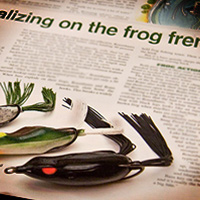
Contradicting Bassmaster Frog Articles
Published March 10, 2010 by Kevin Scarselli
This summer I read a column in August’s issue of BASS Times (a newspaper publication put out by B.A.S.S.) on page 8 titled, “Capitalizing on the Frog Frenzy: Valuable tips from top pros who are scoring with them“. The article offered tips for fishing frogs from two of the best frog anglers on tour, Dean Rojas and Fred Roumbanis.
About halfway through the article, I read something that shocked me so much that I just had to call someone to share with them what I had just read. So I made a call to a fishing colleague and read to him the following line, as printed in the BASS Times article…
“When bass explode on their frogs, Roumbanis and Rojas immediately slam home the hooks. This breaks a widely held frog fishing tenet: Thou shalt count to two before setting the hook.”
My friend on the other end was equally as shocked. We couldn’t believe that we had been wrong about how to most effectively set the hook on a frog fish. As avid frog anglers ourselves having much experience with these blowups, we’ve learned the hard way through the years how hair trigger hooksets can cause missed fish. When a bass blows up on my frog, I had always stayed calm, reeled up the slack, and when I felt the fish, drove those hooks home. It’s worked for me and it worked for my colleague. Could we have been wrong all this time?

We were both skeptical to say the least. But who am I to argue with Dean Rojas about frog fishing? He designed the very frog I throw most often and is at the forefront of frog fishing strategy. Not to mention, Fred Roumbanis backs this hookset technique as well. How can I argue against all that firepower?
For weeks this BASS Times column lingered in the back of my mind.
Then, a few weeks later I noticed another Frog article posted at Bassmaster.com (the same organization that publishes BASS Times and Bassmaster Magazine). It was published on August 28th and titled, “Rojas, Frogs and Bass: Part 2 of 2“. I was ready to read what I thought would be the final nail in my own frog hookset coffin.
Anxiously reading, I finally got to the part I was waiting for. It quoted Dean Rojas and read…
“Don’t get in a hurry when you get a strike. This is probably the biggest mistake most anglers make when they’re frog fishing. Wait at least a couple of seconds after the strike before you set the hook. Allow the bass to get the bait in his or her mouth before you try to cross its eyes and drive the hook home.
I know it’s not easy… But you’ve got to do it. If you snap the rod too quick, you’ll pull the lure back before the bass really has it and all you’ll get are regrets.”
Hold on. WHAT!? Just a few weeks ago BASS Times told me Rojas and Roumbanis slam the hooks home immediately on a blow up. Now, a couple weeks later B.A.S.S. is quoting Rojas as saying that setting the hook instantly is “probably the biggest mistake most anglers make when they’re frog fishing”.
What’s going on here? Is one of them a misprint? Did Dean change his mind within that 3-4 week period? Maybe there was some sort of communication error between the writer and Rojas/Roumbanis?
Hopefully we’ll find out the true story here behind Rojas’ (and Roumbanis’) frog hookset strategy. My money is on the “wait a bit to feel the fish first before setting the hook” tenet. But that BASS Times column was very clear cut about this topic… no vagary at all regarding the immediate hookset recommendation.
If Dean and Fred concur that the immediate hook set is the more effective method, then I’ll take their word for it.. they are incredible frog anglers. But with two strongly opposing columns like this, I think we are all left wondering what the true story is behind the frog hookset. It’s a shame, because I really want to know.
So Dean… Fred… let us know what the real deal is on these hooksets. We’re anxious to find out.







